Zhenyu Wang
Bridging BCI and Communications: A MIMO Framework for EEG-to-ECoG Wireless Channel Modeling
May 16, 2025Abstract:As a method to connect human brain and external devices, Brain-computer interfaces (BCIs) are receiving extensive research attention. Recently, the integration of communication theory with BCI has emerged as a popular trend, offering potential to enhance system performance and shape next-generation communications. A key challenge in this field is modeling the brain wireless communication channel between intracranial electrocorticography (ECoG) emitting neurons and extracranial electroencephalography (EEG) receiving electrodes. However, the complex physiology of brain challenges the application of traditional channel modeling methods, leaving relevant research in its infancy. To address this gap, we propose a frequency-division multiple-input multiple-output (MIMO) estimation framework leveraging simultaneous macaque EEG and ECoG recordings, while employing neurophysiology-informed regularization to suppress noise interference. This approach reveals profound similarities between neural signal propagation and multi-antenna communication systems. Experimental results show improved estimation accuracy over conventional methods while highlighting a trade-off between frequency resolution and temporal stability determined by signal duration. This work establish a conceptual bridge between neural interfacing and communication theory, accelerating synergistic developments in both fields.
StablePCA: Learning Shared Representations across Multiple Sources via Minimax Optimization
May 02, 2025Abstract:When synthesizing multisource high-dimensional data, a key objective is to extract low-dimensional feature representations that effectively approximate the original features across different sources. Such general feature extraction facilitates the discovery of transferable knowledge, mitigates systematic biases such as batch effects, and promotes fairness. In this paper, we propose Stable Principal Component Analysis (StablePCA), a novel method for group distributionally robust learning of latent representations from high-dimensional multi-source data. A primary challenge in generalizing PCA to the multi-source regime lies in the nonconvexity of the fixed rank constraint, rendering the minimax optimization nonconvex. To address this challenge, we employ the Fantope relaxation, reformulating the problem as a convex minimax optimization, with the objective defined as the maximum loss across sources. To solve the relaxed formulation, we devise an optimistic-gradient Mirror Prox algorithm with explicit closed-form updates. Theoretically, we establish the global convergence of the Mirror Prox algorithm, with the convergence rate provided from the optimization perspective. Furthermore, we offer practical criteria to assess how closely the solution approximates the original nonconvex formulation. Through extensive numerical experiments, we demonstrate StablePCA's high accuracy and efficiency in extracting robust low-dimensional representations across various finite-sample scenarios.
Large Language Models in Bioinformatics: A Survey
Mar 06, 2025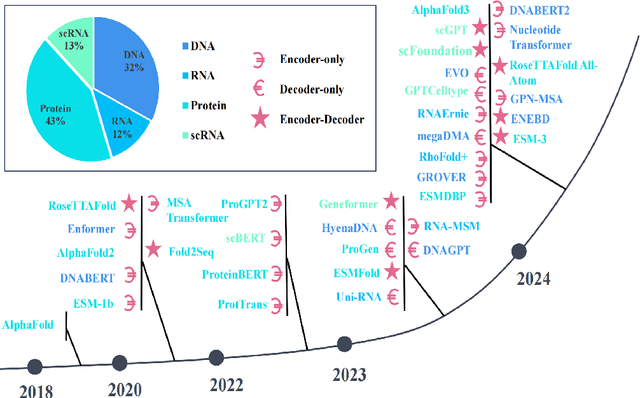
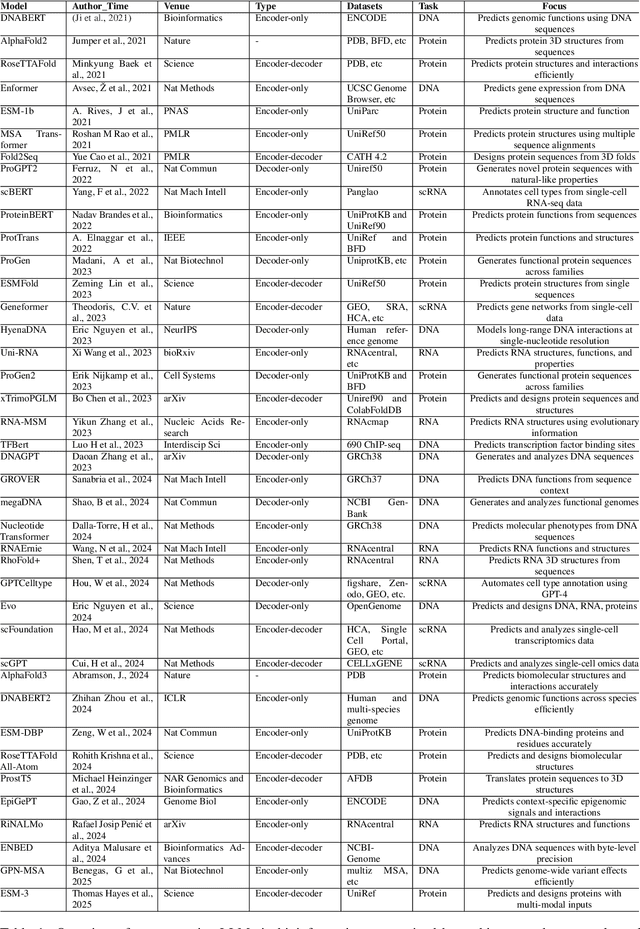
Abstract:Large Language Models (LLMs) are revolutionizing bioinformatics, enabling advanced analysis of DNA, RNA, proteins, and single-cell data. This survey provides a systematic review of recent advancements, focusing on genomic sequence modeling, RNA structure prediction, protein function inference, and single-cell transcriptomics. Meanwhile, we also discuss several key challenges, including data scarcity, computational complexity, and cross-omics integration, and explore future directions such as multimodal learning, hybrid AI models, and clinical applications. By offering a comprehensive perspective, this paper underscores the transformative potential of LLMs in driving innovations in bioinformatics and precision medicine.
A Fusion Model for Artwork Identification Based on Convolutional Neural Networks and Transformers
Feb 27, 2025
Abstract:The identification of artwork is crucial in areas like cultural heritage protection, art market analysis, and historical research. With the advancement of deep learning, Convolutional Neural Networks (CNNs) and Transformer models have become key tools for image classification. While CNNs excel in local feature extraction, they struggle with global context, and Transformers are strong in capturing global dependencies but weak in fine-grained local details. To address these challenges, this paper proposes a fusion model combining CNNs and Transformers for artwork identification. The model first extracts local features using CNNs, then captures global context with a Transformer, followed by a feature fusion mechanism to enhance classification accuracy. Experiments on Chinese and oil painting datasets show the fusion model outperforms individual CNN and Transformer models, improving classification accuracy by 9.7% and 7.1%, respectively, and increasing F1 scores by 0.06 and 0.05. The results demonstrate the model's effectiveness and potential for future improvements, such as multimodal integration and architecture optimization.
A Fusion Model for Art Author Identification Based on Convolutional Neural Networks and Transformers
Feb 26, 2025
Abstract:The identification of art authors is crucial in areas like cultural heritage protection, art market analysis, and historical research. With the advancement of deep learning, Convolutional Neural Networks (CNNs) and Transformer models have become key tools for image classification. While CNNs excel in local feature extraction, they struggle with global context, and Transformers are strong in capturing global dependencies but weak in fine-grained local details. To address these challenges, this paper proposes a fusion model combining CNNs and Transformers for art author identification. The model first extracts local features using CNNs, then captures global context with a Transformer, followed by a feature fusion mechanism to enhance classification accuracy. Experiments on Chinese and oil painting datasets show the fusion model outperforms individual CNN and Transformer models, improving classification accuracy by 9.7\% and 7.1\%, respectively, and increasing F1 scores by 0.06 and 0.05. The results demonstrate the model's effectiveness and potential for future improvements, such as multimodal integration and architecture optimization.
A Collaborative Jade Recognition System for Mobile Devices Based on Lightweight and Large Models
Feb 20, 2025Abstract:With the widespread adoption and development of mobile devices, vision-based recognition applications have become a hot topic in research. Jade, as an important cultural heritage and artistic item, has significant applications in fields such as jewelry identification and cultural relic preservation. However, existing jade recognition systems still face challenges in mobile implementation, such as limited computing resources, real-time requirements, and accuracy issues. To address these challenges, this paper proposes a jade recognition system based on size model collaboration, aiming to achieve efficient and accurate jade identification using mobile devices such as smartphones.First, we design a size model based on multi-scale image processing, extracting key visual information by analyzing jade's dimensions, shapes, and surface textures. Then, a collaborative multi-model classification framework is built by combining deep learning and traditional computer vision algorithms. This framework can effectively select and adjust models based on different jade characteristics, providing high accuracy results across various environments and devices.Experimental results show that the proposed system can provide high recognition accuracy and fast processing time on mobile devices, while consuming relatively low computational resources. The system not only holds great application potential but also provides new ideas and technical support for the intelligent development of jade identification.
RoboMIND: Benchmark on Multi-embodiment Intelligence Normative Data for Robot Manipulation
Dec 18, 2024Abstract:Developing robust and general-purpose robotic manipulation policies is a key goal in the field of robotics. To achieve effective generalization, it is essential to construct comprehensive datasets that encompass a large number of demonstration trajectories and diverse tasks. Unlike vision or language data that can be collected from the Internet, robotic datasets require detailed observations and manipulation actions, necessitating significant investment in hardware-software infrastructure and human labor. While existing works have focused on assembling various individual robot datasets, there remains a lack of a unified data collection standard and insufficient diversity in tasks, scenarios, and robot types. In this paper, we introduce RoboMIND (Multi-embodiment Intelligence Normative Data for Robot manipulation), featuring 55k real-world demonstration trajectories across 279 diverse tasks involving 61 different object classes. RoboMIND is collected through human teleoperation and encompasses comprehensive robotic-related information, including multi-view RGB-D images, proprioceptive robot state information, end effector details, and linguistic task descriptions. To ensure dataset consistency and reliability during policy learning, RoboMIND is built on a unified data collection platform and standardized protocol, covering four distinct robotic embodiments. We provide a thorough quantitative and qualitative analysis of RoboMIND across multiple dimensions, offering detailed insights into the diversity of our datasets. In our experiments, we conduct extensive real-world testing with four state-of-the-art imitation learning methods, demonstrating that training with RoboMIND data results in a high manipulation success rate and strong generalization. Our project is at https://x-humanoid-robomind.github.io/.
Causal Invariance Learning via Efficient Optimization of a Nonconvex Objective
Dec 17, 2024



Abstract:Data from multiple environments offer valuable opportunities to uncover causal relationships among variables. Leveraging the assumption that the causal outcome model remains invariant across heterogeneous environments, state-of-the-art methods attempt to identify causal outcome models by learning invariant prediction models and rely on exhaustive searches over all (exponentially many) covariate subsets. These approaches present two major challenges: 1) determining the conditions under which the invariant prediction model aligns with the causal outcome model, and 2) devising computationally efficient causal discovery algorithms that scale polynomially, instead of exponentially, with the number of covariates. To address both challenges, we focus on the additive intervention regime and propose nearly necessary and sufficient conditions for ensuring that the invariant prediction model matches the causal outcome model. Exploiting the essentially necessary identifiability conditions, we introduce Negative Weight Distributionally Robust Optimization (NegDRO), a nonconvex continuous minimax optimization whose global optimizer recovers the causal outcome model. Unlike standard group DRO problems that maximize over the simplex, NegDRO allows negative weights on environment losses, which break the convexity. Despite its nonconvexity, we demonstrate that a standard gradient method converges to the causal outcome model, and we establish the convergence rate with respect to the sample size and the number of iterations. Our algorithm avoids exhaustive search, making it scalable especially when the number of covariates is large. The numerical results further validate the efficiency of the proposed method.
Grid-augmented vision: A simple yet effective approach for enhanced spatial understanding in multi-modal agents
Dec 03, 2024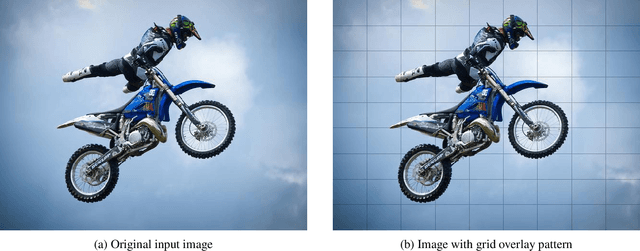
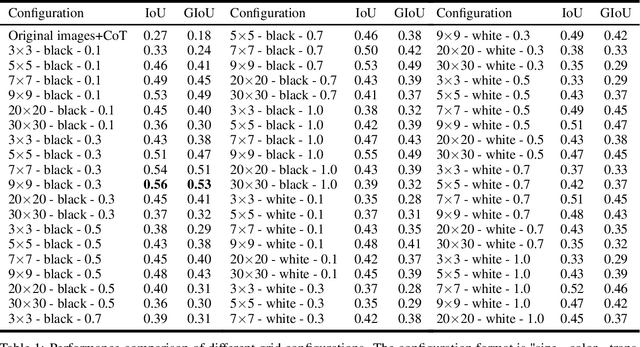
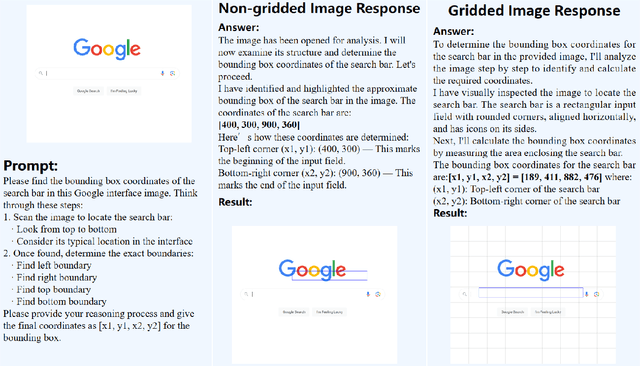
Abstract:Recent advances in multimodal models have demonstrated impressive capabilities in object recognition and scene understanding. However, these models often struggle with precise spatial localization - a critical capability for real-world applications. Inspired by how humans use grid-based references like chess boards and maps, we propose introducing explicit visual position encoding through a simple grid overlay approach. By adding a 9x9 black grid pattern onto input images, our method provides visual spatial guidance analogous to how positional encoding works in transformers, but in an explicit, visual form. Experiments on the COCO 2017 dataset demonstrate that our grid-based approach achieves significant improvements in localization accuracy, with a 107.4% increase in IoU (from 0.27 to 0.56) and a 194.4% improvement in GIoU (from 0.18 to 0.53) compared to baseline performance. Through attention visualization analysis, we show how this visual position encoding helps models better ground spatial relationships. Our method's simplicity and effectiveness make it particularly valuable for applications requiring accurate spatial reasoning, such as robotic manipulation, medical imaging, and autonomous navigation.
SJTU:Spatial judgments in multimodal models towards unified segmentation through coordinate detection
Dec 03, 2024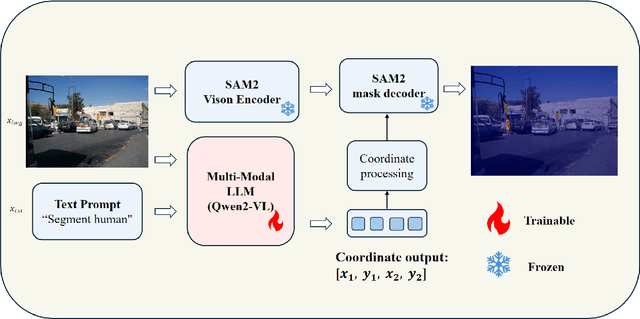
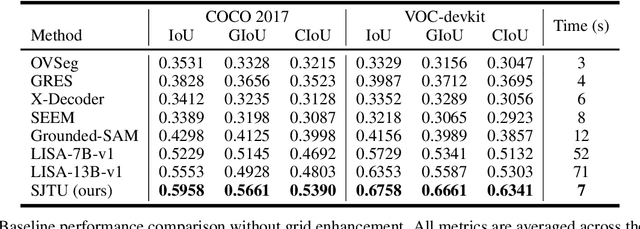
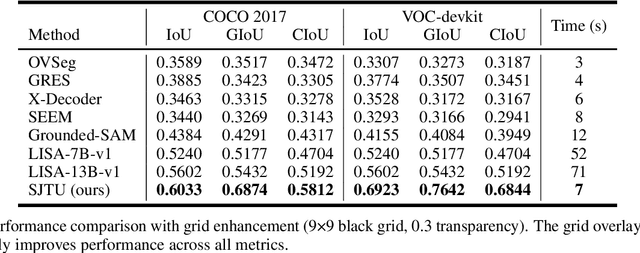
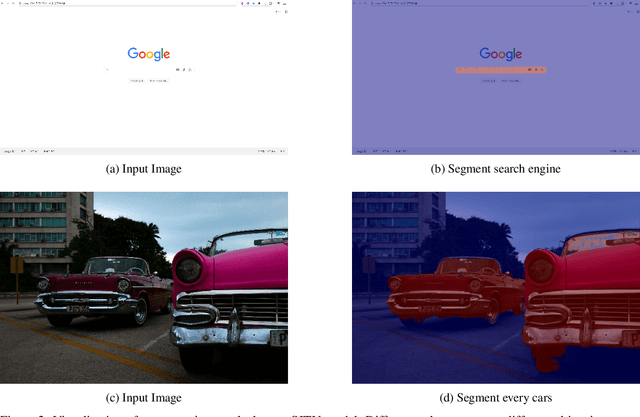
Abstract:Despite advances in vision-language understanding, implementing image segmentation within multimodal architectures remains a fundamental challenge in modern artificial intelligence systems. Existing vision-language models, which primarily rely on backbone architectures or CLIP-based embedding learning, demonstrate inherent limitations in fine-grained spatial localization and operational capabilities. This paper introduces SJTU: Spatial Judgments in multimodal models - Towards Unified segmentation through coordinate detection, a novel framework that leverages spatial coordinate understanding to bridge vision-language interaction and precise segmentation, enabling accurate target identification through natural language instructions. The framework proposes a novel approach for integrating segmentation techniques with vision-language models based on multimodal spatial inference. By leveraging normalized coordinate detection for bounding boxes and translating it into actionable segmentation outputs, we explore the possibility of integrating multimodal spatial and language representations. Based on the proposed technical approach, the framework demonstrates superior performance on various benchmark datasets as well as accurate object segmentation. Results on the COCO 2017 dataset for general object detection and Pascal VOC datasets for semantic segmentation demonstrate the generalization capabilities of the framework.
 Add to Chrome
Add to Chrome Add to Firefox
Add to Firefox Add to Edge
Add to Edge